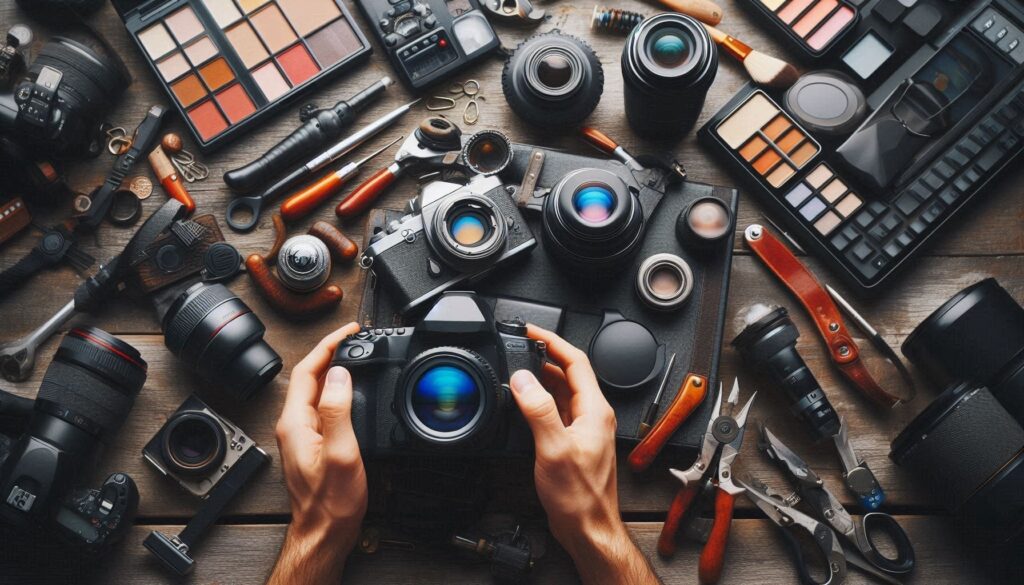
In today’s fast-paced, visually driven world, the art of photography has become more accessible and diverse than ever. Whether you’re a seasoned professional or an enthusiastic beginner, having the right knowledge, tools, and techniques is critical to capturing breathtaking visuals.
Our comprehensive guide dives deep into cameras, lenses, and digital photography to empower photographers at every skill level. From understanding technical specifications to mastering creative techniques, this is your one-stop resource to perfect your craft.
Understanding Camera Types and Their Uses
DSLR Cameras: The Classic Powerhouses
DSLRs (Digital Single-Lens Reflex cameras) are renowned for their versatility and image quality. Ideal for professional photographers, these cameras feature:
- Interchangeable Lenses: Adaptable to various photography styles.
- Optical Viewfinders: Offer real-time image previews.
- Extensive Manual Controls: Perfect for fine-tuning every shot.
Best Use Cases: Portraits, wildlife, and studio photography.
Mirrorless Cameras: Compact Yet Powerful
Mirrorless cameras are the modern solution for photographers seeking lightweight, efficient equipment without sacrificing quality. Key benefits include:
- Electronic Viewfinders (EVFs): Preview adjustments in real time.
- Improved Autofocus Systems: Exceptional performance in low-light conditions.
- Silent Shooting Mode: Ideal for events and street photography.
Best Use Cases: Travel, event coverage, and videography.
Point-and-Shoot Cameras: Simple and Portable
For those who prioritize portability and ease of use, point-and-shoot cameras are excellent choices. Features include:
- Built-In Lenses: Simplified operation.
- Compact Design: Convenient for everyday photography.
Best Use Cases: Casual photography, vacations, and family events.
Selecting the Perfect Lens for Every Scenario
Your camera is only as good as the lens it carries. Here’s how to choose the right lens for your photography needs:
Wide-Angle Lenses
- Focal Length: 14mm to 35mm
- Ideal For: Landscapes, architecture, and group shots
- Key Benefit: Captures vast scenes with minimal distortion.
Standard Lenses
- Focal Length: 35mm to 70mm
- Ideal For: Everyday photography and portraits
- Key Benefit: Natural field of view, mimicking human sight.
Telephoto Lenses
- Focal Length: 70mm and above
- Ideal For: Wildlife, sports, and distant subjects
- Key Benefit: Compresses perspective, making distant objects appear closer.
Macro Lenses
- Focal Length: 50mm to 200mm
- Ideal For: Close-up shots of small subjects like insects and flowers
- Key Benefit: High magnification for intricate details.
Mastering Photography Techniques
Composition Essentials
Good composition elevates your photos from ordinary to extraordinary. Here are some principles to follow:
- Rule of Thirds: Divide the frame into a 3×3 grid and place subjects along the intersections.
- Leading Lines: Use natural lines to guide the viewer’s eye.
- Symmetry and Patterns: Create visual harmony with balanced elements.
Lighting Techniques
Light is the essence of photography. Experiment with:
- Golden Hour Photography: Capture warm, soft light during sunrise and sunset.
- Artificial Lighting: Master flash and studio lights for controlled environments.
- Low-Light Photography: Use tripods and high ISO settings for stunning night shots.
Post-Processing: Perfecting Your Images
Software Essentials
- Adobe Lightroom: Ideal for color correction and exposure adjustments.
- Adobe Photoshop: Perfect for advanced retouching and compositing.
Tips for Effective Editing
- Stay Subtle: Avoid over-editing for a more natural look.
- Preserve Original Files: Always work on duplicates to retain your original images.
- Enhance Details: Sharpen specific areas like eyes and textures for added focus.
Keeping Up with Camera Trends
Photography technology is constantly evolving. Here’s what to watch out for:
- AI-Enhanced Cameras: Intelligent features for automated scene detection and focus.
- 8K Video Capabilities: Expanding possibilities for hybrid photo-video creators.
- Sustainable Gear: Eco-friendly materials and energy-efficient designs.
Frequently Asked Questions
What’s the Best Camera for Beginners?
We recommend starting with entry-level mirrorless cameras like the Sony Alpha series or Canon EOS M50 for their user-friendly controls and excellent image quality.
How Do I Choose the Right Lens?
Consider your primary photography style. A wide-angle lens works best for landscapes, while a telephoto lens is ideal for capturing distant subjects.
How Can I Improve My Photography Skills?
Practice consistently, experiment with different genres, and stay updated with the latest tutorials and resources.
Conclusion
Photography is a blend of art and science, requiring the perfect balance of technical know-how and creative vision. By selecting the right equipment, mastering techniques, and staying inspired, you can create stunning visuals that resonate deeply.
Whether you’re capturing your first photo or refining your portfolio, let this guide serve as your trusted companion. Together, let’s unlock the full potential of your photography journey.